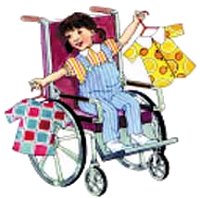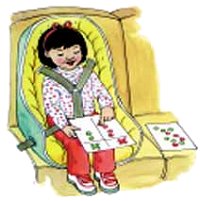|

Activities for Your Day
Getting Up in the Morning
Jordan was getting dressed slowly so Mommy decided to try something new. "Jordan," said Mommy, "if you can get ready and be in the kitchen in 15 minutes, you can pick out whatever cereal you like." Jordan was ready in 10 minutes.
- When you get your children up in the morning, ask them to stretch as high as they can. Then let them hop or crawl across the room. Even sleepyheads can have fun using their muscles, and these movements help them understand themselves in space.
- Morning is a good time for children to learn that some things take longer than others. Use a timer or hourglass that is set to a given number of minutes and see if your children can get dressed in that amount of time. They can try to do other activities in that same amount of time.
- If you don't have a timer of some kind, count out loud evenly..."1 second, 2 seconds..." as children get dressed to see how many seconds it takes them to get dressed. Children will hear the numbers, which will help them learn to count, and they will begin to develop a sense of duration.
- When your children get dressed, ask them to match the colors of their clothes. "Let's wear yellow today. Can you find your shirt with the yellow duck?" As they get older, ask them to look for patterns in their clothing. There can be patterns with alternating colors, stripes or plaids, squares or circles, or pictures-like big flowers followed by little flowers. Ask children to find and describe patterns, "My shirt has a pattern. It is red, blue, red, blue." Patterns are tools that we use to solve problems because they help us predict what comes next.
- Discuss the events of the day with your children: first we eat breakfast, then you go to child care or school, then we will go to the park.
- With your older child, say when events will happen in the morning, afternoon, evening, or night. "In the morning we get up. In the evening we go to bed." This will help your children understand the sequence of events is another pattern. Knowing what comes next helps us find structure in our world and helps children feel secure and confident.
- Ask your children to estimate how many spoonfuls it will take to finish their cereal. Count each spoonful as they eat. This playful way of eating breakfast can be fun for toddlers to practice counting! If you repeat this activity over time, older children will get practice in predicting.
- In the morning, read a thermometer or listen to the radio to hear the weather forecast. Then, ask your children what clothes they should wear that day. This will give meaning to the temperatures you just read or heard. You might even compare the temperature inside with the temperature outside.
 In the Car, Subway, or Bus
In the Car, Subway, or Bus
While Daddy was driving Morgan to child care, he pointed to the yield sign and said, "Look, Morgan, a triangle!" As he drove past a highway sign, Daddy asked, "What shape is that sign, Morgan?" Morgan happily shouted, "It's a rectangle, Daddy!"
- Little children can learn the names of different shapes. Traffic signs are a good place to start. Yield signs are triangles, highway signs are rectangles, and stop signs are octagons. Ask children about the signs they see. "Is this sign just like one you saw on another block?" Talk about how many sides it has, or how many corners it has. Older children may talk a lot about what they saw. "That sign is a rectangle. It has 4 sides and 4 corners." But for younger children, you may be doing most of the talking, "That sign is yellow. It is shaped like a triangle."
- Children can also learn to create shapes. Ask your children to draw the shape of the street sign in the air.
- Children learn that people communicate with symbols. Again, traffic signs are a good place to start. You might point out how the shape of the street sign helps people know what the sign means. Point out that the yellow triangle means let the other car go first, the red sign with so many sides (eight sides-octagon) means stop. The link between symbols and the concepts they represent is not always clear to children. Keep restating the meaning, but don't push. Children will make the connection when they are ready.
- Have your children "estimate" how many minutes it will take to walk or drive big sister or brother to school. Using a clock or watch, time how long it really takes and compare your children's estimate with the actual time. "I think it takes 6 hours to walk Marcus to school. No, it only took 5 minutes. Six hours is a really long time." This will help them develop a sense of the passage of time. Children learn by thinking for themselves: let them make their own estimates and then check out their accuracy.
- Compare to see which takes longer: riding to Tio Raul's on the bus or in a car. Mathematics will help your children answer questions from their own world.
- Think of a number between 1 and 10. Give your children clues like "bigger" or "smaller" and ask them to guess the number. Besides being a fun way to pass the journey, it will help your children develop a "mental number line" as they think about different numbers and how they relate to one another.
- Show your children how to make a graph out of stickers so they can record when the stoplights are red or green. To start, take a piece of paper or cardboard and draw a line down the middle to make two columns-one with a red x on the top and the other with a green x on the top. Ask them to put a mark in the red column every time you stop at a red light and a mark in the green column when you go through a green light. Then ask them if there were more red than green, fewer red than green, or the same number of each. Children will learn a little about data recording and interpreting and see that numbers can tell them something about their own life.
- Ask children to look for numbers in the environment, like the numbers on street signs, storefronts, or license plates. Talk about the different things people use numbers for-like finding things, naming things, or giving out other information like prices.
- Play license plate games. Read aloud the numbers on license plates; find a license plate with the number two; or look for license plates with your child's age on them. Children can practice recognizing numbers or finding patterns.
- Sing songs that rhyme, repeat, or have numbers in them. Examples are "Twinkle, Twinkle, Little Star" and "One, Two, Buckle My Shoe." These songs reinforce patterns in words and sound, and are playful ways for children to practice language and mathematics skills. Try a backwards counting song, like "Five Little Monkeys" to reinforce children's understanding of the fixed ordering of numbers.
- Practice counting. Ask children to count to a specific number, count until you arrive at your destination, or just count as high as they can go.
- Count the telephone poles as you pass them. This not only practices counting but also gives children a sense of rhythm and its relationship to time and space.
Math Activities for Ages Two to Five:
|
|
|